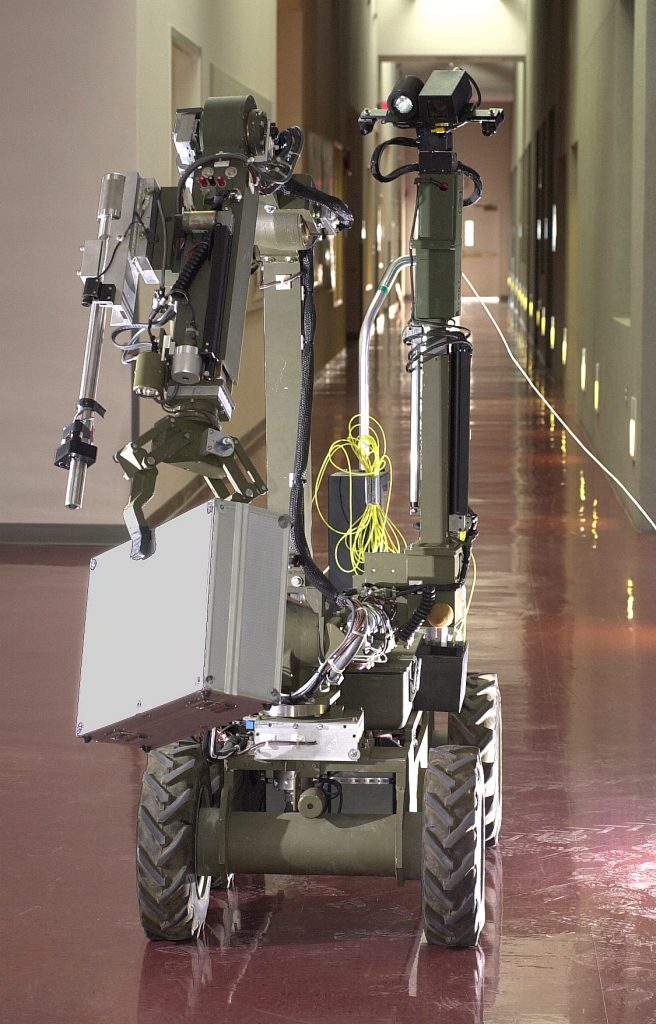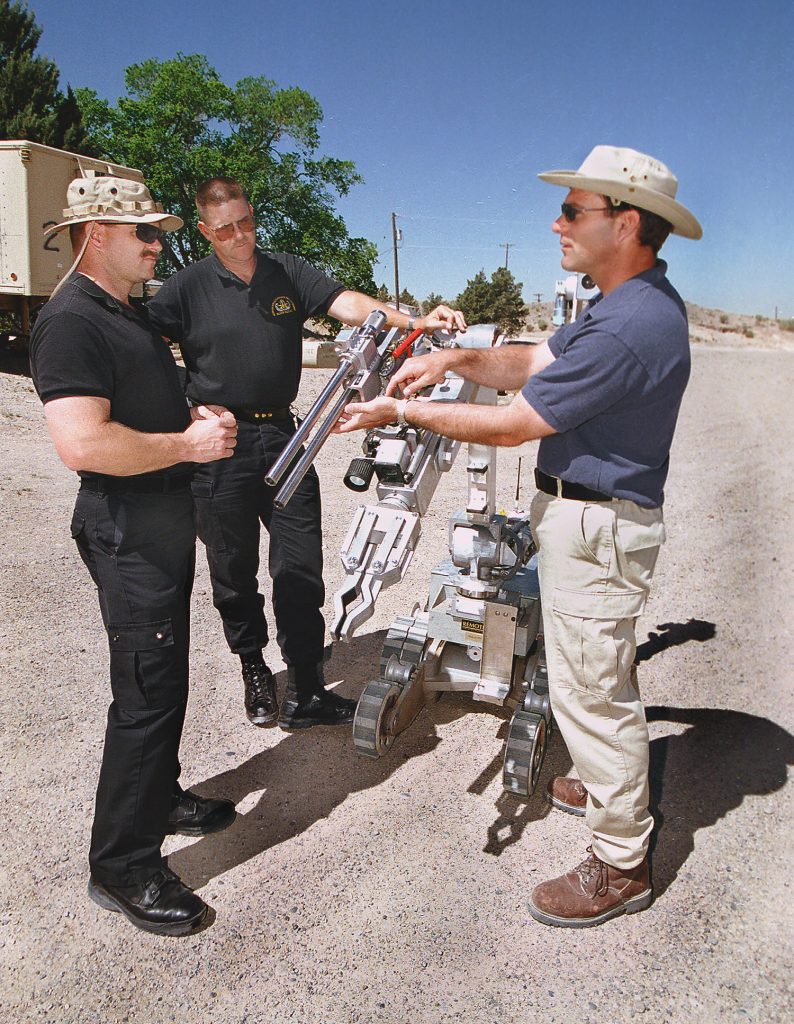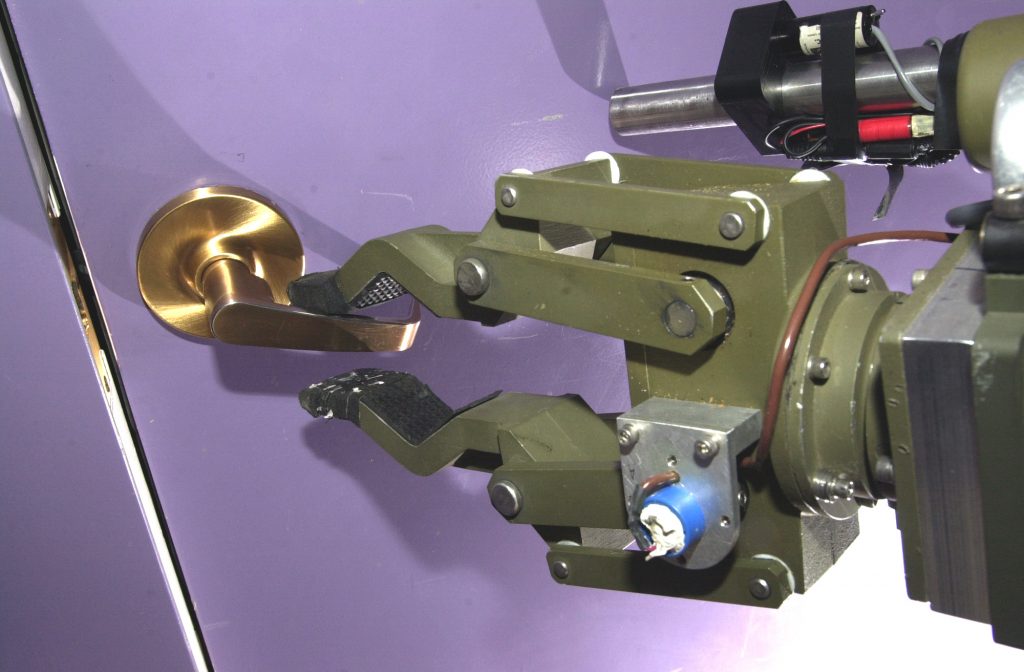
Download 300dpi JPEG image, Newbombbot.jpg, 1.9MB (Media are welcome to download/publish this image with related news stories.)
ALBUQUERQUE, N.M. — Researchers at Sandia National Laboratories have unveiled a wheeled police robot that makes many of the “how to” decisions on its own, freeing up its operator to make the more critical “what to do next” decisions during potentially dangerous bomb-disablement or other law enforcement missions.
In collaboration with REMOTEC Inc. of Oak Ridge, Tenn., Sandia developed and installed new software on a robot on loan from REMOTEC. The software automates many of the robot’s movements while retaining the operator’s ability to command the robot’s behaviors.
The software, called SMART, for Sandia Modular Architecture for Robotics and Teleoperation, is expected to make police robots quicker, safer, easier to operate, and capable of more behaviors. It also is expected to make available to on-scene commanders a greater number of tools for responding to a wider variety of situations.
“Most importantly, it should minimize ‘time on target’ for human bomb techs,” says Sandia project leader Phil Bennett.
The robot was unveiled during the International Association of Bomb Technicians and Investigators annual in-service training conference last week in Albuquerque, which drew some 700 law enforcement officers from around the world.
REMOTEC, a subsidiary of Northrop Grumman Corporation, is currently in the process of licensing the use of the SMART software from Sandia.
“This is the first step in solidifying and expanding the relationship between REMOTEC and Sandia,” says Mack Barber, REMOTEC President.
Difficult work under intense pressure
Law enforcement agencies worldwide are welcoming mobile robots into their special ops units to perform tasks that would normally put an officer in danger. Robots outfitted with cameras, grippers, and other sensors and tools are particularly useful during bomb threat responses because a robot can enter a dangerous area, assess the situation, and handle explosive devices while the human operator is safely behind a control panel hundreds of feet away.
But today’s police robots can be difficult to operate. A robot’s driver, often working under the pressures of limited time and the threat of severe economic consequences associated with mistakes, has to master control levers for each joint of a robotic arm, as well as for a robot’s on-board grippers, cameras, and other tools. The operator has to operate the arm while the camera views might be upside down and backwards. Furthermore, the operator has difficulty judging distances through the cameras, which provide limited depth-of-field information.

Download 300dpi JPEG image, Robodiscuss.jpg, 1.3MB (Media are welcome to download/publish this image with related news stories.)
“Sometimes it’s like playing a video game with a seven-lever joystick sitting upside down, with one eye closed, and with your boss looking over your shoulder,” says Bennett. “Operators might think they’re about to bump an object but they’re really three feet away. Or they don’t know if the robot will be able to fit between two cars or climb a flight of stairs. Often they don’t accomplish these difficult tasks on the first try. The pressure can be intense.”
A SMART-based robot with associated sensors and other tools could be pre-programmed, using software control sequences that allow it to grip tool A or go directly to point X rather than having individual movements controlled separately by the operator.
“That would be useful, for instance, when you need to reach through a car window, grab an object, and back out without whacking the door,” says Bennett. “It will free up the human operator to think about what needs to happen and in what order — which is what humans do better than machines — rather than the monotonous and sometimes confusing details of moving joints.”
Guarantees a stable system
A robotic system is more than just hardware, adds Bennett. When you assemble a robotic system, you need a control system that integrates the hardware components electronically in such a way that you have a stable, useful tool.
SMART’s patented control algorithms guarantee that a variety of components, perhaps from different vendors, can be integrated into a single system and work correctly the first time, says Bob Anderson, Sandia developer of the software. SMART has been demonstrated on robots used by the Department of Energy for accident response and hazardous waste cleanup.
“SMART overcomes obstacles to system stability in unstructured environments,” he says. In addition, SMART’s “stackable” software modules — one for each robot component or function — enables the rapid assembly of off-the-shelf equipment into a working system.
“That’s what has us really excited,” says Bennett. “A sergeant can look at the situations and problems officers are encountering in the field and essentially add this tool or that behavior to the robot’s portfolio without the technical difficulties normally associated with changes to the system.”
It also will allow new tools to be integrated into commercial robotic systems perhaps weeks after they are developed or introduced, rather than months or years.
Sophisticated behaviors to come
Prior to incorporating SMART into REMOTEC’s Wolverine robot, Bennett worked with the FBI to survey law enforcement robot operators across the country to determine which robot tasks and problems officers encountered in the field most frequently. Bennett also observed the challenges encountered by Albuquerque Police Department bomb squad members as they practiced dealing with mock explosive devices using their own REMOTEC robot.
The Wolverine now incorporates some of the most challenging and commonly needed robotic tools and behaviors in police work, such as automatic tool changes, tool placement, and bomb-disrupter aiming, as well as telerobotic straight-line movement in all directions.

Download 300dpi JPEG image, roboclaw.jpg, 1.7MB (Media are welcome to download/publish this image with related news stories.)
During a demonstration in March at the FBI Hazardous Devices School, the SMART-modified Wolverine shaved minutes off typical bomb responses even with the most skilled FBI robot operators.
Bennett expects that REMOTEC and Sandia will begin introducing new tools, sensors, and behaviors for additional law enforcement needs soon. Possible new technologies could include path planning, machine vision, proximity sensing, obstacle avoidance, visual targeting, reachability analysis, and automatic calibration, which would enable a variety of new, sophisticated capabilities.
“We could add sensors and software to the robot that would, for instance, tell the operator in advance whether or not the robot is going to be able to fit between two parked cars, turn left, reach through a window, remove an object, and get out,” says Bennett, “and then it could do all that automatically if the operator decides that’s the right approach.”
Bennett hopes law enforcement agencies one day will be able to select and download new behaviors or tool modules from a network or off of a CD-ROM and insert them into their robots’ control systems.
Ultimately Bennett believes SMART-based mobile robots could be useful in such areas as emergency response (to clean up a chemical spill, for instance), facility security (to patrol perimeters or respond to an attack), nuclear reactor accident response (to turn on or off a safety valve), combat engineering (to breach barriers, lay razor wire, or remove or emplace an object and get out), urban warfare (to punch access holes in walls or assist the injured), and space exploration (using Earth-supervised robotic manipulators to repair satellites in space, for example).
REMOTEC, a unit of Los Angeles-based Northrop Grumman, is a world leader in ground robotic vehicles, having delivered more than 1,500 vehicles worldwide. REMOTEC’s home page is located at www.remotec-andros.com.
REMOTEC contact:
Jack Martin, jack_m_martin@md.northgrum.com, (410) 765-4441